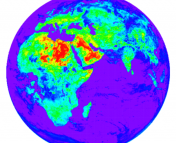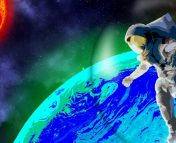Title: Biosignatures of the Earth I. Airborne spectropolarimetric detection of photosynthetic life
Authors: C.H. Lucas Patty, Jonas G. Kühn, Petar H. Lambrev, Stefano Spadaccia, H. Jens Hoeijmakers, Christoph Keller, Willeke Mulder, Vidhya Pallichadath, Olivier Poch, Frans Snik, Daphne M. Stam, Antoine Pommerol, Brice O. Demory
First Author’s Institution: Physikalisches Institut, Universität Bern
Status: Published in Astronomy & Astrophysics (closed access), available on ArXiv (https://arxiv.org/abs/2106.00493)
With the advent of heliocentrism came what we now call the Copernican principle. As a cosmological and philosophical idea, it states that the Earth is not uniquely placed in the universe, nor is the Earth unique compared to any of the other celestial objects we can observe. As Carl Sagan said in Cosmos (1980), “… we live on an insignificant planet of a humdrum star lost in a galaxy tucked away in some forgotten corner of a universe in which there are far more galaxies than people.” For most of the last few centuries, this has held up as a good way to approach our study of the universe.
However, there’s one challenge here: Earth is currently the only planet known to harbor life. Although we think life can arise elsewhere in the Solar System and the universe, we’ve never detected life anywhere other than Earth. Current exobiology searches focus on detecting gases in exoplanetary atmospheres that would be produced by alien biology, but these signals would often be too small to detect. Solving this requires bigger and more sensitive telescopes, mostly limited by financial and political will. A potentially harder problem to solve is that of ambiguous biosignatures: spectral signals that could be produced by life, or by abiotic sources such as geology or other chemical processes. It may not always be possible to rule out false positives for these biosignatures. Therefore, searching for unambiguous biosignatures may be the best path forward to detecting extraterrestrial life.
Going Chiral
One such universal biosignature may already be all around us in our basic molecular structure. Certain molecules, including most biologically relevant ones, tend to be “chiral”, or existing in separate symmetry configurations that can’t be superimposed. As an example, hold your hands together: your right and left hands can’t be rotated in any way to appear identical, but always appear to be mirror images of each other. In abiotic chemistry, molecule chirality (its “handedness”, either left or right) tends to be equally distributed between configurations. However, biological chemistry nearly always prefers a specific configuration, or is “homochiral”.

Although other biosignatures may be identified through spectroscopy alone, molecular chirality needs spectroscopy as well as polarization information. Observing the spectrum of reflected sunlight off of a leaf tells us what molecules the leaf is made of, but inorganic materials may show similar spectra. If we also observe the polarization of the reflected sunlight, we can see the chirality of the molecules in the leaf. Homochiral molecules in a leaf circularly polarize light, while inorganic molecules do not. Although this signal is small compared to the spectral signature of chlorophyll in plants, this paper successfully demonstrates the detection of circular polarization from plants on Earth, with a simulated remote sensing platform.
The authors have been working on instruments to make these sorts of measurements for several years now. Instead of static lab conditions they mounted their spectropolarimeter on a helicopter and flew it around Switzerland. Over their flight path, they observed several different biological targets such as trees and grass, as well as abiotic targets such as roads and buildings, measuring the fractionally induced circular polarization as a function of wavelength.

Faint Signals, Strong Evidence
The team found significant differences in the polarization signal for each imaging target, and also found that the variability of the polarization depends on how long they observed a target. Even with a short exposure of only 3 seconds, the team was able to distinguish forest, grass, and urban area with a signal-to-noise ratio for forests of 14 and a signal-to-noise ratio of 5 for grass. Water and urban areas were relatively flat compared to vegetation, and the urban areas had higher noise, possibly due to building geometry, as well as linearly polarized glass reflections. The authors also note the presence of the vegetation red edge signal in the forest, grass, and water data, where chlorophyll abruptly starts to reflect near-infrared light, indicating the presence of photosynthetic organisms.
There’s a lot more work that needs to be done before this technique is ready to discover exoplants on exoplanets! This work didn’t examine the dependence of the signal on observation phase angles, which would be necessary before trying to observe this on transiting planets near secondary eclipse in reflected light. In general, the signals are also very faint, putting them out of reach of our near-term observational capabilities for exo-Earths around Sun-like stars. However, circularly polarized light would be a strong indicator of homochirality and could be one of many lines of evidence for extraterrestrial life in the future.
Astrobite edited by Ben Cassese
Featured image credit: Ian Creek, Wikimedia




